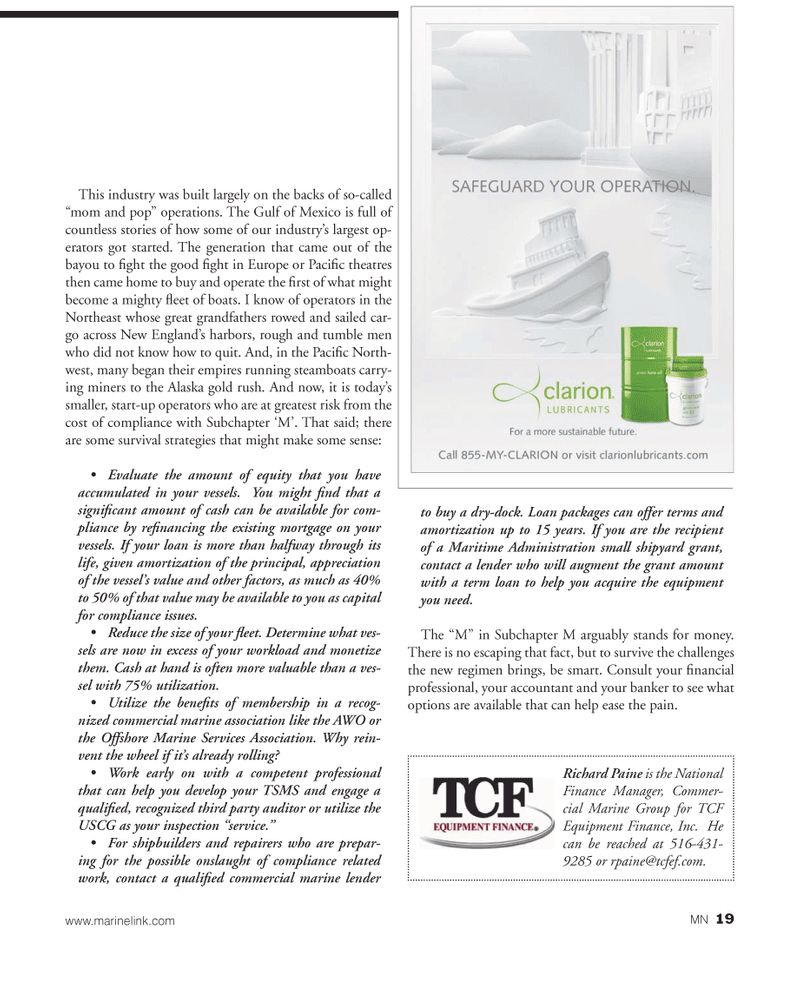
Page 19: of Marine News Magazine (September 2013)
Workboat Annual
Read this page in Pdf, Flash or Html5 edition of September 2013 Marine News Magazine
This industry was built largely on the backs of so-called mom and pop? operations. The Gulf of Mexico is full of countless stories of how some of our industrys largest op- erators got started. The generation that came out of the bayou to ? ght the good ? ght in Europe or Paci? c theatres then came home to buy and operate the ? rst of what might become a mighty ? eet of boats. I know of operators in the Northeast whose great grandfathers rowed and sailed car- go across New Englands harbors, rough and tumble men who did not know how to quit. And, in the Paci? c North- west, many began their empires running steamboats carry- ing miners to the Alaska gold rush. And now, it is todays smaller, start-up operators who are at greatest risk from the cost of compliance with Subchapter M. That said; there are some survival strategies that might make some sense: ? Evaluate the amount of equity that you have accumulated in your vessels. You might ? nd that a signi? cant amount of cash can be available for com- pliance by re? nancing the existing mortgage on your vessels. If your loan is more than halfway through its life, given amortization of the principal, appreciation of the vessels value and other factors, as much as 40% to 50% of that value may be available to you as capital for compliance issues.? Reduce the size of your ? eet. Determine what ves- sels are now in excess of your workload and monetize them. Cash at hand is often more valuable than a ves- sel with 75% utilization.? Utilize the bene? ts of membership in a recog- nized commercial marine association like the AWO or the Offshore Marine Services Association. Why rein- vent the wheel if its already rolling? ? Work early on with a competent professional that can help you develop your TSMS and engage a quali? ed, recognized third party auditor or utilize the USCG as your inspection service.? ? For shipbuilders and repairers who are prepar- ing for the possible onslaught of compliance related work, contact a quali? ed commercial marine lender to buy a dry-dock. Loan packages can offer terms and amortization up to 15 years. If you are the recipient of a Maritime Administration small shipyard grant, contact a lender who will augment the grant amount with a term loan to help you acquire the equipment you need. The M? in Subchapter M arguably stands for money. There is no escaping that fact, but to survive the challenges the new regimen brings, be smart. Consult your ? nancial professional, your accountant and your banker to see what options are available that can help ease the pain. Richard Paine is the National Finance Manager, Commer- cial Marine Group for TCF Equipment Finance, Inc. He can be reached at 516-431- 9285 or [email protected]. MN 19www.marinelink.com MN Sept2013 Layout 18-31.indd 198/29/2013 11:12:05 AM

 18
18

 20
20
